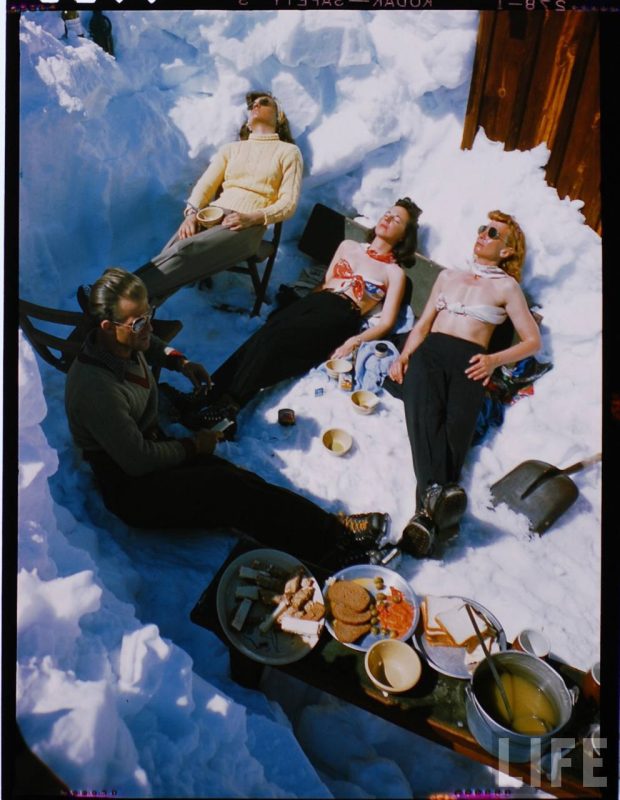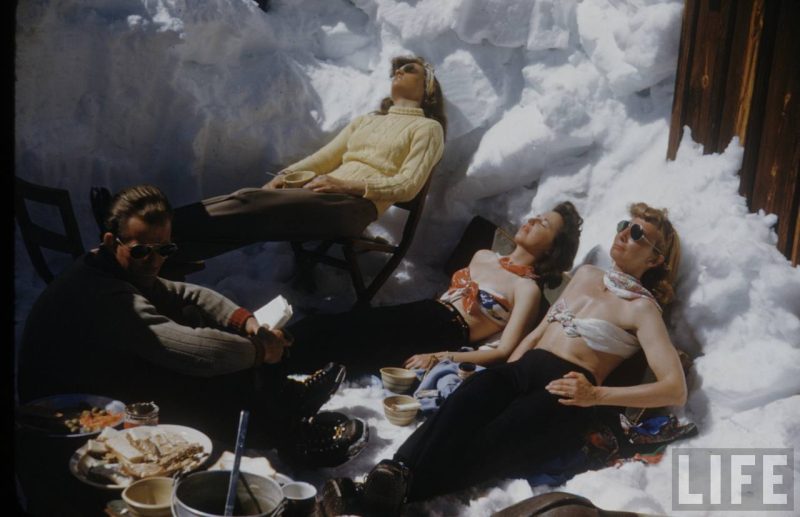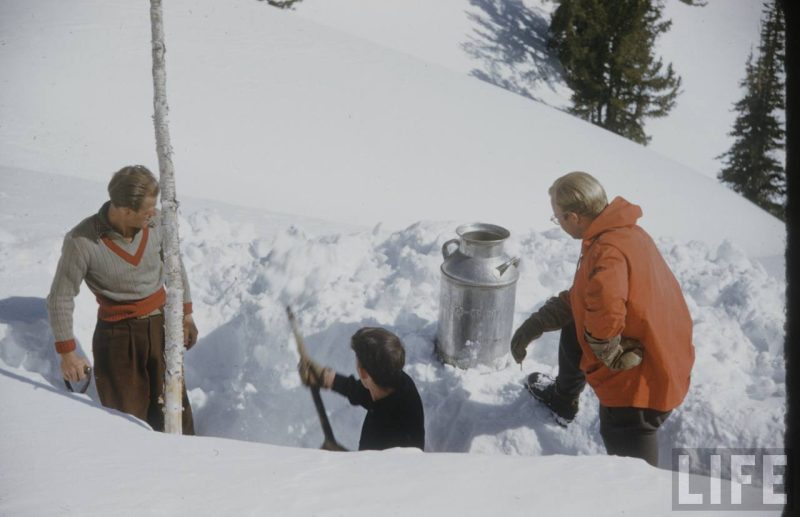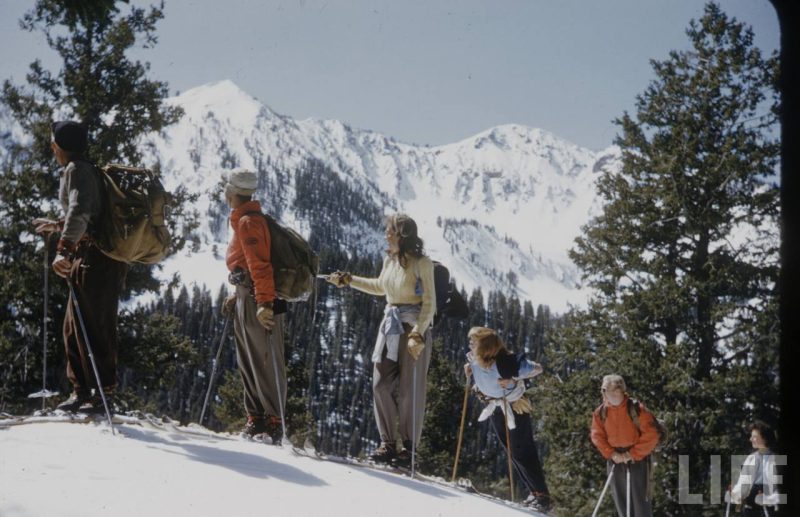
I’ve been trying to spend less time online. It’s been pretty good. I’ve been creating, I’ve been sewing, I’ve been reading, I’ve been spending time with my family.
I ventured to open a browser window to Facebook, and, lo and behold, what wonders awaited me. In my “Suggested Posts” popped up this lovely image, shared in a group with attribution to the photographer and background info. This image did not have the “LIFE” logo in the lower corner, or the photograph border.
The comment section was RIFE with misinformation. Countless claims of “THIS IS AI”. “No one dressed like that back then.” “Those are mannequins”. “FAKE.” “No one would leave out lox for a photograph. Fake.”
I went on a bit of internet sleuthing, as I suspected it was from Life Magazine, and remembered there is a whole Life Magazine archive online. I typed in the information given by the poster, and, lo and behold, up popped the original image. You can see it here.
This image is, indeed, by George Silk for Life Magazine and was taken in 1946. It’s titled “Sun Valley Skiing, Idaho”, and it is a color transparency (slide).
There is no doubt that the introduction of AI (Artificial Intelligence) is problematic- not only for artists trying to make a living through their medium, who’s artwork is often stolen to generate AI, but also for historians trying to study and examine the past. We see so many images now claiming to be historical images.
The occurrence of AI being presented as a historical image is often innocent enough. Someone, somewhere on the internet, sees an image. Having a mediocre familiarity with nostalgia, this person takes it to be a historical image based on aesthetic and shares it with a vague attribution, such as “Paris, 1890s”. The hair, the vaguely old-fashioned clothes, images in black and white, all of these make the average person, only familiar with history through historical representation through film and media, to assume it’s an old image.
But those familiar with whatever their particular niche of history is, can pick out the differences even in AI which is decently done. Decently done meaning they most likely possess the correct amount of fingers that are in the correct position on the hand, the cars look like they might actually be able to have a motor in them and have the correct number of wheels, and text is real and not a hodge podge of lines mimicking actual letters. And sewing machine operators sit on the correct side of the machines. Usually the people in the image are quite thin and what we think of as “attractive” during the current period. They almost never wear corsets. They often have smooth, clear complexions with some appearance of makeup. Of course, the more advanced the AI the more realistic the image- I’m just giving a brief overview for those new to dupe-spotting.
However, the reverse aspect of how current society views the past was apparent in their response to this skiing image by jumping to claim it’s AI, when it is, in actuality, a real historical photograph. People take their preconceived notion of what the past looked like and apply it to actual historical images to tout them as fakes.
Let’s see it again.

What makes people assume this photo is fake?
First, it’s in color. The general public is not always aware that color photographs existed as early as 1861. Then progressed the Autochrome, Kodachrome, and Agfacolor eras. The general public could purchase color film. I have very few, but do have, some family photos taken with color film in the 1940s.
People also don’t see the entrance to this little snow-hideout, which is obviously to the right. It appears they magically appeared in a snow hut with a view from above (scroll down to see them actually digging the hideout from snow).
People not familiar with the fact that picnics were popular through all of history, and people were not limited to restaurants and lodge food. A layout of food in the snow? Must be fake! When it was, actually, this was relatively common to have food “en plain air”.
But mostly I don’t think they’re used to “vintage women” looking like this. Tops with just a scarf tied about their upper section? Shock and scandal! Obviously phony! And the makeup tone is a bit off on the face of the person at right. This happens now, too. Most obvious to me- real people do have a gloss on their complexion when outside. If this was AI we would replace this with an ideal hazy complexion free of blemish and shine. Or, at least, only shine in places that are the most attractive.
The past was not as prudish as we make it out to be. Sure, you may think grandma might not have bared her midsection in strapless fashion with just a bit of cloth (although I have seen photos of my grandmother sunbathing in a similar manner, though in sand, not snow), but Sun Valley, Idaho was the realm of the fashionable and elite in this era. There was, in fact, a whole movie about it. And although the Hayes code meant that film was censored for suitability, life was most certainly uncensored. People may argue that they had “manners”. But I’ve heard about those wild Hollywood afterparties. Whoo boy. There’s nothing new under the sun. And “manners” are subjective.
But this image does not strike me as particularly scandalous. Tying scarves for tops was done in this period by normal, average people who wanted to sunbathe. Plus, having skied as a kid and young adult, there’s times I would have gladly pulled off all those layers for some fresh air. Especially when the sun came out. I think the tied scarf tops with the ski pants and boots is pretty neat, actually.
OF COURSE it’s a staged photograph. Sure, they may have been in a similar position and jostled things around for composition. But it’s a Life Magazine shot. This isn’t your standard family snapshot. It’s like claiming Vogue Magazine was staged. Of course it was. And may I direct you to all the “influencers” on social media these days. It’s no different. It doesn’t mean the photograph is fake, or that it proves it is not an actual, historical photograph showing vintage people. It’s a lifestyle shot, just like we get today, meant to evoke feeling. And it’s a darn good photograph. Who hasn’t moved a little pile of projects or laundry just a little off-camera when taking a photograph to share? Why wouldn’t our vintage predecessors do likewise?
As an aside, the man at lower left looks a lot like my grandfather. And my husband owns that aluminum cooking set. And those are actual Camel cigarettes, not a phony logo with fake writing. AI would have to be particularly well versed in historical everyday objects to conjure those up out of nothing. The day may come. But not yet.
As further proof, here’s a second shot, of the same group of people.

And here’s another image, of the same man digging their hideout.

Here’s one of the girl in the yellow sweater with a group of hikers, and the same gentleman as in the sun shot wearing a hat and backpack.

So that’s it. Do a bit a sleuthing, familiarize yourself with actual history.
These old images are a thousand times more striking than AI because they are actual history with actual people and broaden our understanding of what the past looked like.
If we don’t know what came before, we don’t know what lies ahead.

Nicole
April 27, 2024 at 4:59 pm (1 year ago)Very interesting post! I think also that people who live in areas where there isn’t much snow, don’t realize that it can get very warm in the sun, even in the midst of the snow. I live in Alberta, Canada and often in winter people will walk around with their coats unzipped, and the moment the temperature rises, even the slightest, we teasingly say “it’s t-shirt weather!” I’ve even been known to pop outside quick wearing sandals… Anyway, great research into the photo, I quite enjoyed reading it!
Susan
May 1, 2024 at 11:52 am (1 year ago)Thanks for demonstrating how to verify an image. Great work!
Barbara
July 10, 2024 at 4:04 am (1 year ago)Bravo! I am so tired of arguing with people about all sorts of things when it comes to history of the last century. My grandmothers were born in 1880 and 1894 and my Mom and Dad in 1918 and 1919.In a country that went from the cakewalk to 23 skidoo to jive talk, these folks were not staid sticks in the mud, for sure!